S-ITC538 Programming Paradigms: A Comparative Analysis
VerifiedAdded on 2023/03/30
|10
|1123
|372
Essay
AI Summary
This essay delves into the realm of programming paradigms, contrasting the imperative and declarative approaches. It begins by defining a paradigm as a problem-solving methodology in programming. The essay then explores the imperative paradigm, focusing on procedural and object-oriented programming, and the declarative paradigm, encompassing functional and logic programming. It highlights the key differences between these paradigms, such as how imperative programming emphasizes step-by-step instructions, while declarative programming focuses on what needs to be achieved rather than how. The essay also identifies programming languages associated with each paradigm, including C, Java, and SQL. Furthermore, it discusses the specific advantages of each approach, such as the ease of implementation in imperative programming and the data security and reusability features in object-oriented programming. The essay also includes an overview of parallel processing and database programming, which are related to the imperative and declarative paradigms. The essay references sources such as academic papers, books and journals, and provides a chart and figures to explain different paradigms.
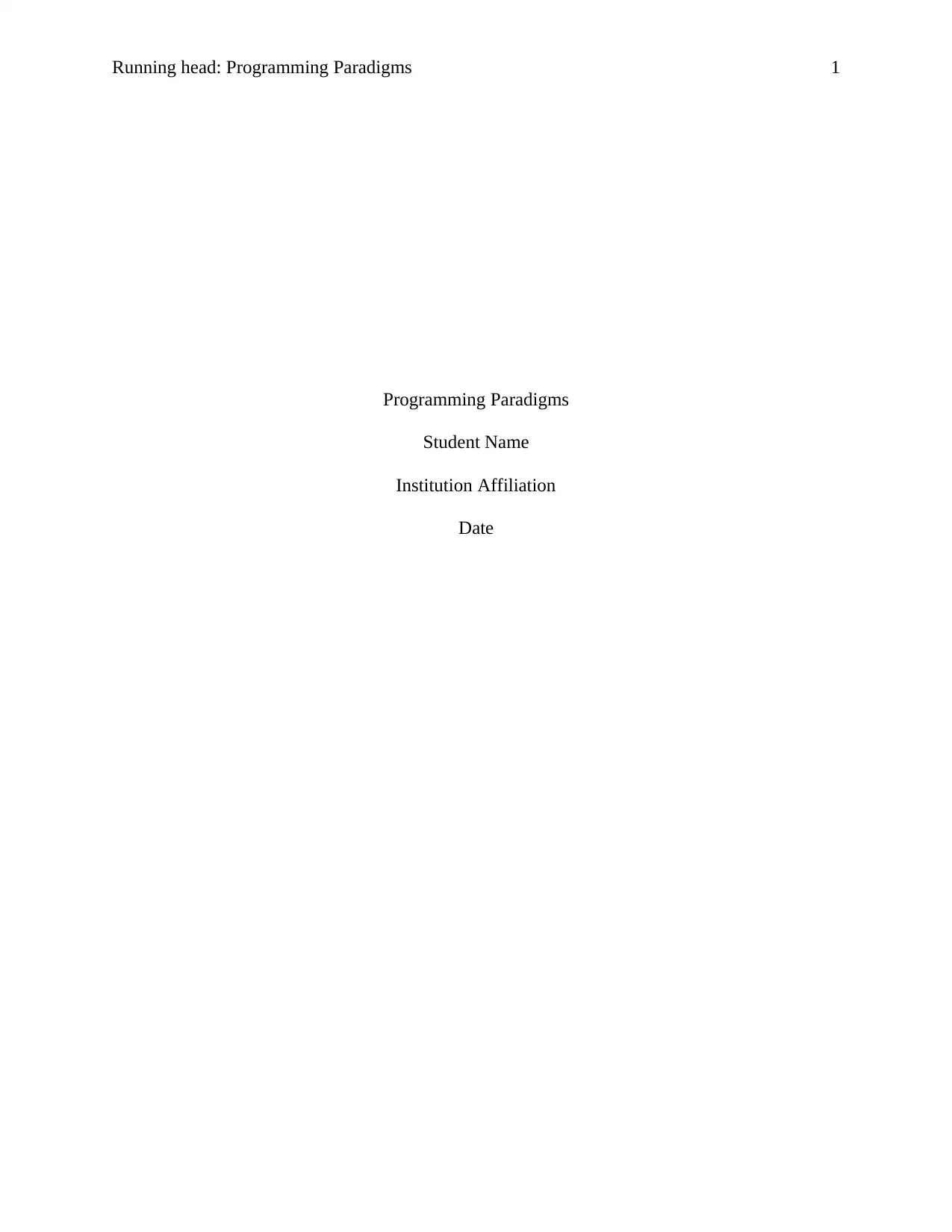
Running head: Programming Paradigms 1
Programming Paradigms
Student Name
Institution Affiliation
Date
Programming Paradigms
Student Name
Institution Affiliation
Date
Paraphrase This Document
Need a fresh take? Get an instant paraphrase of this document with our AI Paraphraser
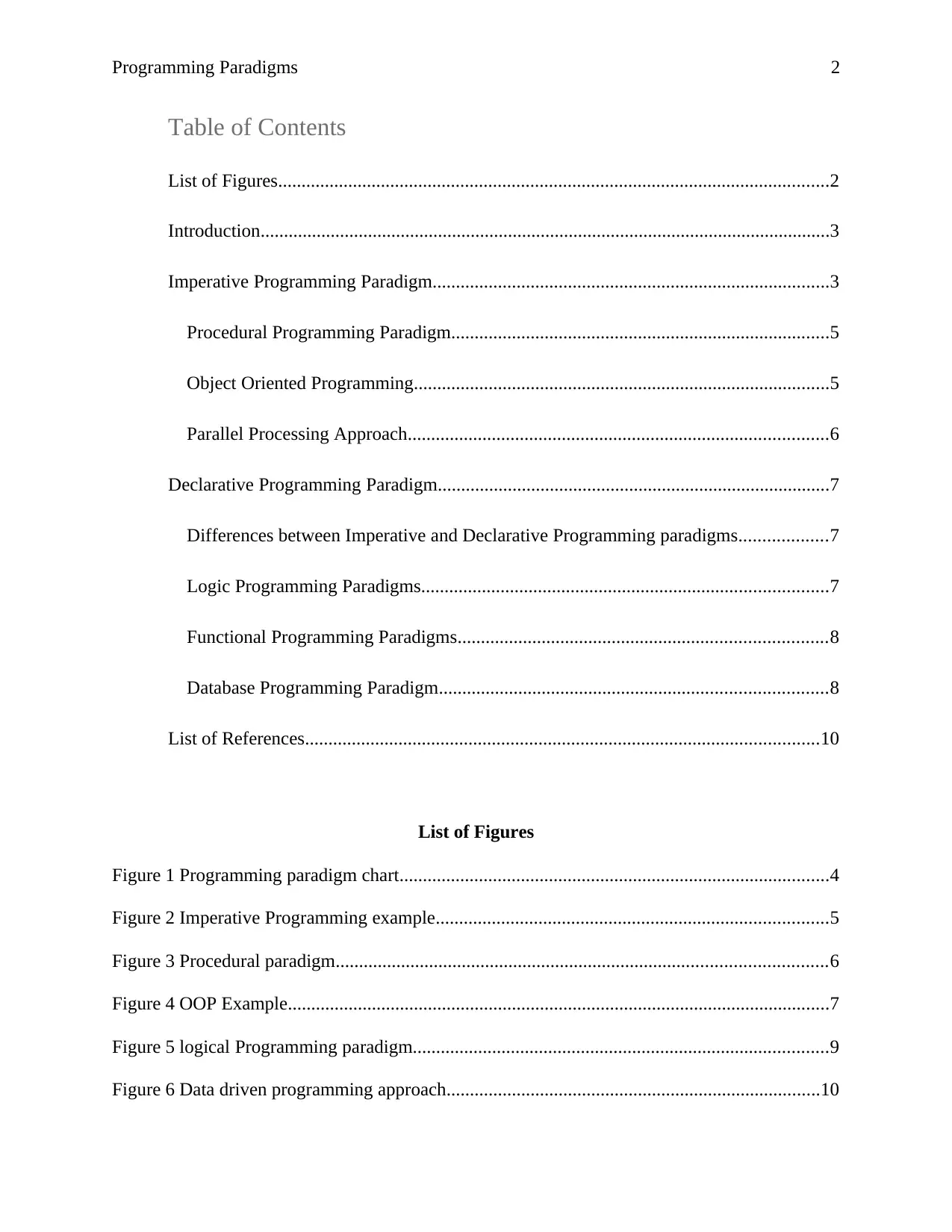
Programming Paradigms 2
Table of Contents
List of Figures......................................................................................................................2
Introduction..........................................................................................................................3
Imperative Programming Paradigm.....................................................................................3
Procedural Programming Paradigm.................................................................................5
Object Oriented Programming.........................................................................................5
Parallel Processing Approach..........................................................................................6
Declarative Programming Paradigm....................................................................................7
Differences between Imperative and Declarative Programming paradigms...................7
Logic Programming Paradigms.......................................................................................7
Functional Programming Paradigms...............................................................................8
Database Programming Paradigm...................................................................................8
List of References..............................................................................................................10
List of Figures
Figure 1 Programming paradigm chart............................................................................................4
Figure 2 Imperative Programming example....................................................................................5
Figure 3 Procedural paradigm.........................................................................................................6
Figure 4 OOP Example....................................................................................................................7
Figure 5 logical Programming paradigm.........................................................................................9
Figure 6 Data driven programming approach................................................................................10
Table of Contents
List of Figures......................................................................................................................2
Introduction..........................................................................................................................3
Imperative Programming Paradigm.....................................................................................3
Procedural Programming Paradigm.................................................................................5
Object Oriented Programming.........................................................................................5
Parallel Processing Approach..........................................................................................6
Declarative Programming Paradigm....................................................................................7
Differences between Imperative and Declarative Programming paradigms...................7
Logic Programming Paradigms.......................................................................................7
Functional Programming Paradigms...............................................................................8
Database Programming Paradigm...................................................................................8
List of References..............................................................................................................10
List of Figures
Figure 1 Programming paradigm chart............................................................................................4
Figure 2 Imperative Programming example....................................................................................5
Figure 3 Procedural paradigm.........................................................................................................6
Figure 4 OOP Example....................................................................................................................7
Figure 5 logical Programming paradigm.........................................................................................9
Figure 6 Data driven programming approach................................................................................10
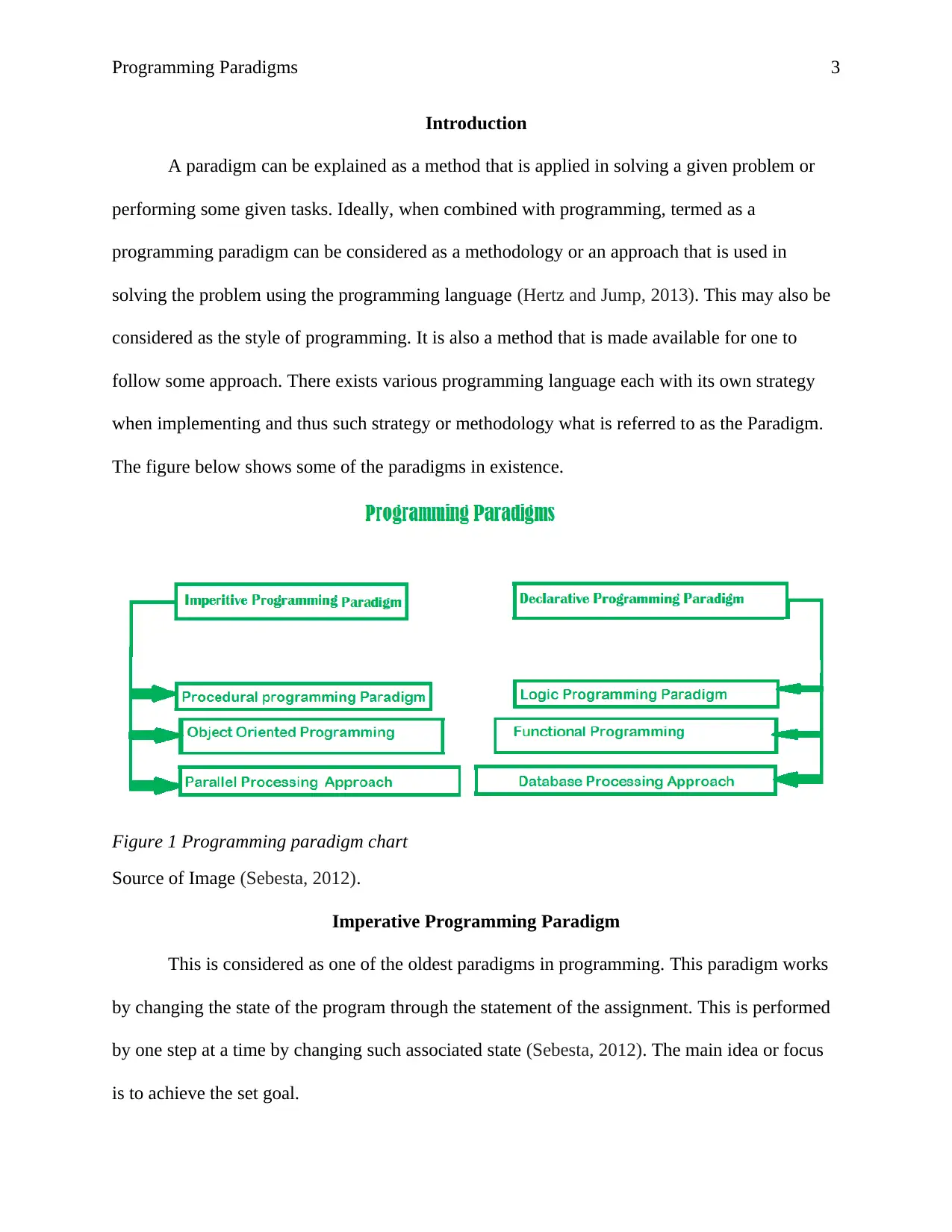
Programming Paradigms 3
Introduction
A paradigm can be explained as a method that is applied in solving a given problem or
performing some given tasks. Ideally, when combined with programming, termed as a
programming paradigm can be considered as a methodology or an approach that is used in
solving the problem using the programming language (Hertz and Jump, 2013). This may also be
considered as the style of programming. It is also a method that is made available for one to
follow some approach. There exists various programming language each with its own strategy
when implementing and thus such strategy or methodology what is referred to as the Paradigm.
The figure below shows some of the paradigms in existence.
Figure 1 Programming paradigm chart
Source of Image (Sebesta, 2012).
Imperative Programming Paradigm
This is considered as one of the oldest paradigms in programming. This paradigm works
by changing the state of the program through the statement of the assignment. This is performed
by one step at a time by changing such associated state (Sebesta, 2012). The main idea or focus
is to achieve the set goal.
Introduction
A paradigm can be explained as a method that is applied in solving a given problem or
performing some given tasks. Ideally, when combined with programming, termed as a
programming paradigm can be considered as a methodology or an approach that is used in
solving the problem using the programming language (Hertz and Jump, 2013). This may also be
considered as the style of programming. It is also a method that is made available for one to
follow some approach. There exists various programming language each with its own strategy
when implementing and thus such strategy or methodology what is referred to as the Paradigm.
The figure below shows some of the paradigms in existence.
Figure 1 Programming paradigm chart
Source of Image (Sebesta, 2012).
Imperative Programming Paradigm
This is considered as one of the oldest paradigms in programming. This paradigm works
by changing the state of the program through the statement of the assignment. This is performed
by one step at a time by changing such associated state (Sebesta, 2012). The main idea or focus
is to achieve the set goal.
⊘ This is a preview!⊘
Do you want full access?
Subscribe today to unlock all pages.

Trusted by 1+ million students worldwide
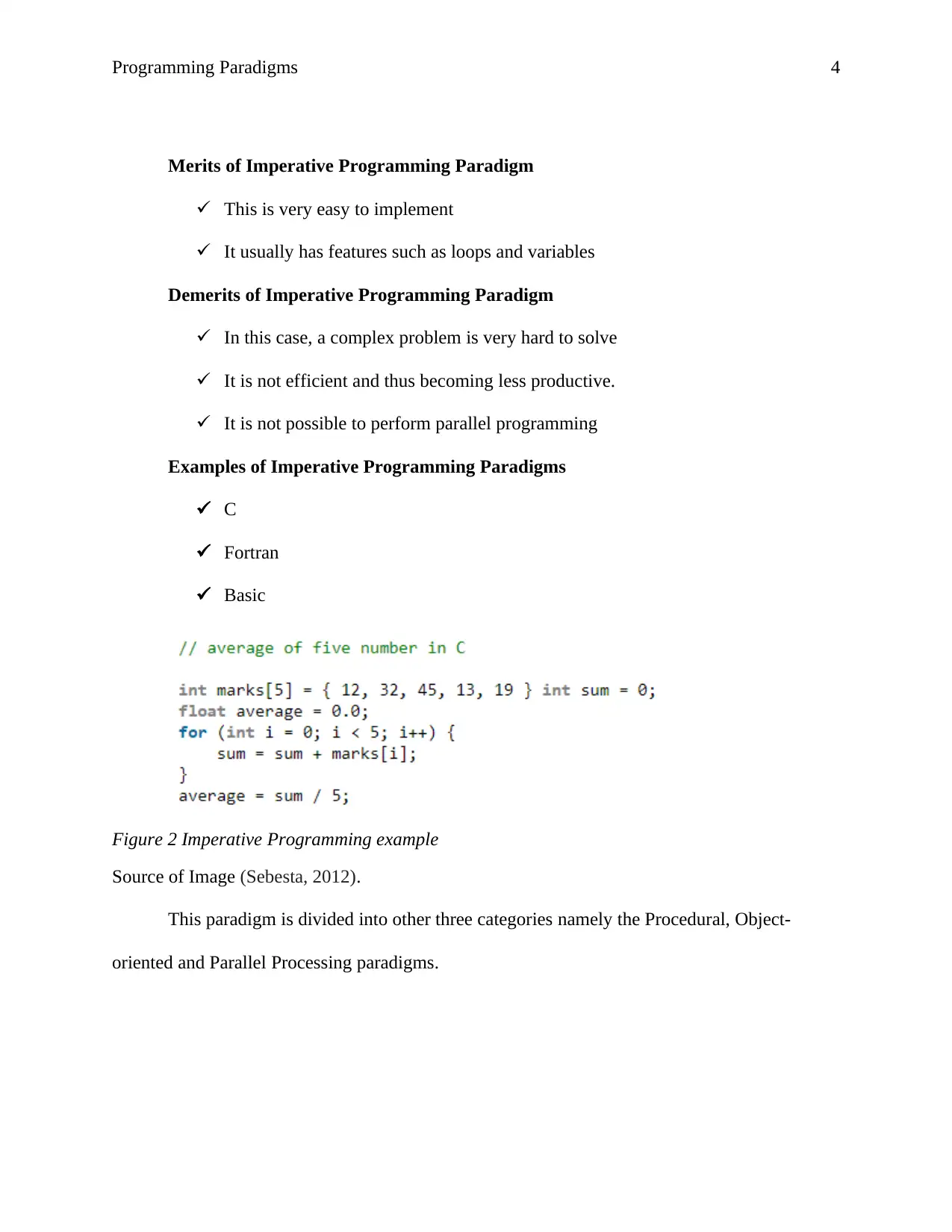
Programming Paradigms 4
Merits of Imperative Programming Paradigm
This is very easy to implement
It usually has features such as loops and variables
Demerits of Imperative Programming Paradigm
In this case, a complex problem is very hard to solve
It is not efficient and thus becoming less productive.
It is not possible to perform parallel programming
Examples of Imperative Programming Paradigms
C
Fortran
Basic
Figure 2 Imperative Programming example
Source of Image (Sebesta, 2012).
This paradigm is divided into other three categories namely the Procedural, Object-
oriented and Parallel Processing paradigms.
Merits of Imperative Programming Paradigm
This is very easy to implement
It usually has features such as loops and variables
Demerits of Imperative Programming Paradigm
In this case, a complex problem is very hard to solve
It is not efficient and thus becoming less productive.
It is not possible to perform parallel programming
Examples of Imperative Programming Paradigms
C
Fortran
Basic
Figure 2 Imperative Programming example
Source of Image (Sebesta, 2012).
This paradigm is divided into other three categories namely the Procedural, Object-
oriented and Parallel Processing paradigms.
Paraphrase This Document
Need a fresh take? Get an instant paraphrase of this document with our AI Paraphraser

Programming Paradigms 5
Procedural Programming Paradigm
This usually put more emphasizes on the procedure and the terms on the model of the
underlying machine. One is capable to reuse the code in existence. Some of the programming
languages are such as C, C++, Java, ColdFusion and Pascal.
Source of Image (Sebesta, 2012).
Figure 3 Procedural paradigm
Object-Oriented Programming
This is usually written in the manner that classes are collected and the object meant for
the communication. All the small and entity which are basic is referred to as the object and all
types of computation can be performed only on the objects (Freitag, Lengauer and Schek, 2012).
The emphasis is given on the data other than on the procedure. Some of the advantages are such
as;
Security of data is high
The class have inheritance features
There is reusing of the code
It is flexible and there is the presence of abstraction
Procedural Programming Paradigm
This usually put more emphasizes on the procedure and the terms on the model of the
underlying machine. One is capable to reuse the code in existence. Some of the programming
languages are such as C, C++, Java, ColdFusion and Pascal.
Source of Image (Sebesta, 2012).
Figure 3 Procedural paradigm
Object-Oriented Programming
This is usually written in the manner that classes are collected and the object meant for
the communication. All the small and entity which are basic is referred to as the object and all
types of computation can be performed only on the objects (Freitag, Lengauer and Schek, 2012).
The emphasis is given on the data other than on the procedure. Some of the advantages are such
as;
Security of data is high
The class have inheritance features
There is reusing of the code
It is flexible and there is the presence of abstraction
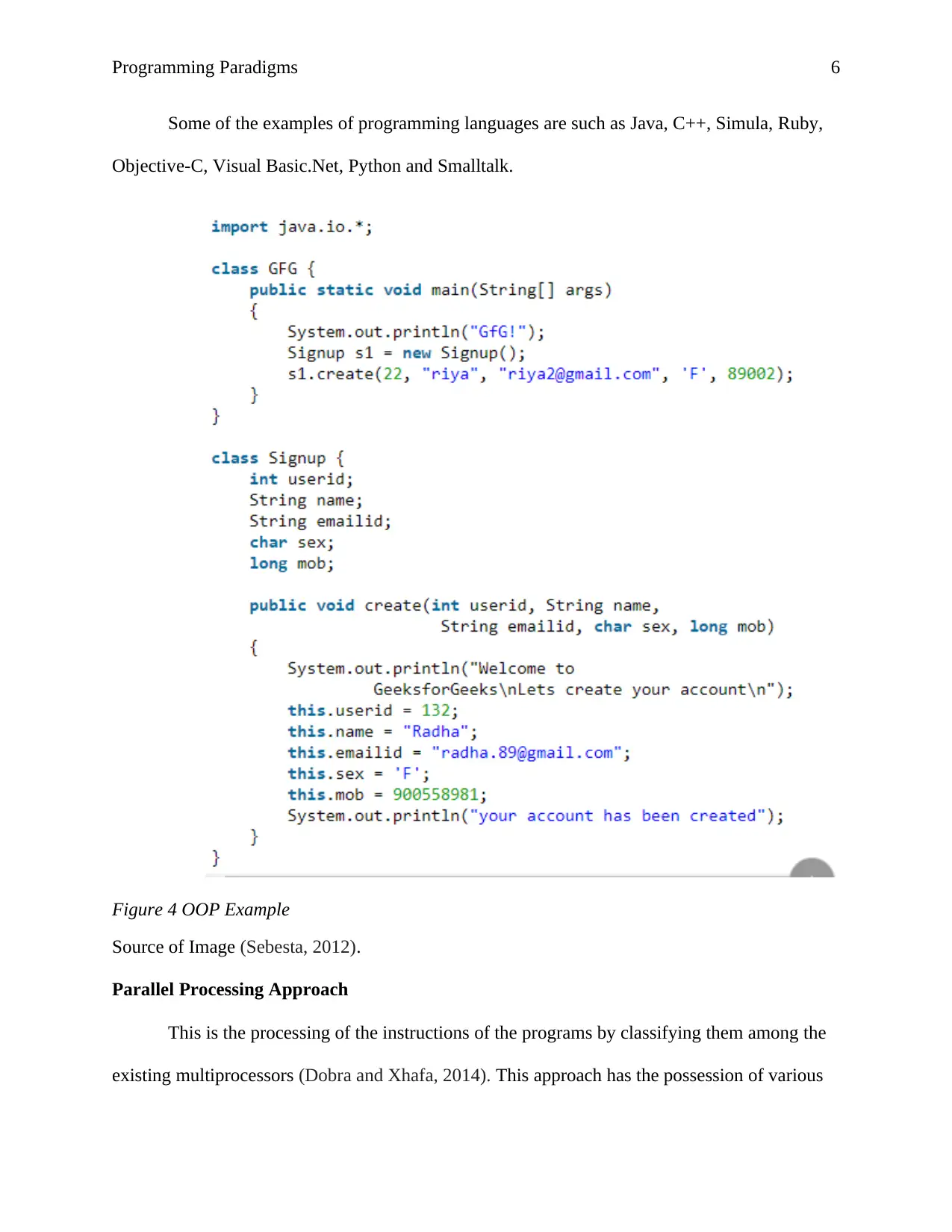
Programming Paradigms 6
Some of the examples of programming languages are such as Java, C++, Simula, Ruby,
Objective-C, Visual Basic.Net, Python and Smalltalk.
Figure 4 OOP Example
Source of Image (Sebesta, 2012).
Parallel Processing Approach
This is the processing of the instructions of the programs by classifying them among the
existing multiprocessors (Dobra and Xhafa, 2014). This approach has the possession of various
Some of the examples of programming languages are such as Java, C++, Simula, Ruby,
Objective-C, Visual Basic.Net, Python and Smalltalk.
Figure 4 OOP Example
Source of Image (Sebesta, 2012).
Parallel Processing Approach
This is the processing of the instructions of the programs by classifying them among the
existing multiprocessors (Dobra and Xhafa, 2014). This approach has the possession of various
⊘ This is a preview!⊘
Do you want full access?
Subscribe today to unlock all pages.

Trusted by 1+ million students worldwide

Programming Paradigms 7
processors with the major goal of running the program using little time by categorizing them.
This approach is similar to the divide and conquers rule. Some of the programming languages are
such as C/C++ and NESL
Declarative Programming Paradigm
This paradigm is usually divided into three types namely the logic, database and
functional. Declarative paradigm can be explained to be a style of constructing programs
showing expression of the logic of the computation without emphasizing much on the control of
the flow. In this case, much focus is on the action to be performed other than how it is supposed
to be done. It basically put more emphasizes on the function of the code.
Differences between Imperative and Declarative Programming paradigms
The major and only difference is that Imperative programming paradigm discusses and
put more emphasis on how to do with the paradigm while declarative programming paradigm
that emphasizes more on what one can do with the paradigms in programming.
Logic Programming Paradigms
This is the model of abstract meant for computation. This is used for solving logical
problems such as the series and puzzles. In this case, one has prior knowledge and the question
which is usually given to the machine so that it can produce the output. The programming
concept is by use of AI as they the perceptions model. See the example below of a prolog.
processors with the major goal of running the program using little time by categorizing them.
This approach is similar to the divide and conquers rule. Some of the programming languages are
such as C/C++ and NESL
Declarative Programming Paradigm
This paradigm is usually divided into three types namely the logic, database and
functional. Declarative paradigm can be explained to be a style of constructing programs
showing expression of the logic of the computation without emphasizing much on the control of
the flow. In this case, much focus is on the action to be performed other than how it is supposed
to be done. It basically put more emphasizes on the function of the code.
Differences between Imperative and Declarative Programming paradigms
The major and only difference is that Imperative programming paradigm discusses and
put more emphasis on how to do with the paradigm while declarative programming paradigm
that emphasizes more on what one can do with the paradigms in programming.
Logic Programming Paradigms
This is the model of abstract meant for computation. This is used for solving logical
problems such as the series and puzzles. In this case, one has prior knowledge and the question
which is usually given to the machine so that it can produce the output. The programming
concept is by use of AI as they the perceptions model. See the example below of a prolog.
Paraphrase This Document
Need a fresh take? Get an instant paraphrase of this document with our AI Paraphraser

Programming Paradigms 8
Figure 5 logical Programming paradigm
Source of Image (Sebesta, 2012).
Functional Programming Paradigms
This usually has its roots in mathematics and it is usually independent of the language.
The major idea behind this paradigm is that it executes the mathematical function series (Hanus,
2013). Abstract central model is the function which means that some specific computations and
not entirely the structure of data. Some of the languages used in this paradigm are such as Perl,
JavaScript, Haskwell, Erlang, Lisp, ML and Clojure.
Database Programming Paradigm
This is usually based on the data and the way such data move. The statements of
programs are usually defined by the used data other than hand-coding the series or sequence of
steps. The database program is considered as the heart of the information system in a business
and offer provision of file creation, entry of data, updates, querying and reporting functionalities.
A good example is SQL which is usually applied to streams of data which is structured, filtering
such data, transformation and aggregation. The example below explains the application.
Figure 5 logical Programming paradigm
Source of Image (Sebesta, 2012).
Functional Programming Paradigms
This usually has its roots in mathematics and it is usually independent of the language.
The major idea behind this paradigm is that it executes the mathematical function series (Hanus,
2013). Abstract central model is the function which means that some specific computations and
not entirely the structure of data. Some of the languages used in this paradigm are such as Perl,
JavaScript, Haskwell, Erlang, Lisp, ML and Clojure.
Database Programming Paradigm
This is usually based on the data and the way such data move. The statements of
programs are usually defined by the used data other than hand-coding the series or sequence of
steps. The database program is considered as the heart of the information system in a business
and offer provision of file creation, entry of data, updates, querying and reporting functionalities.
A good example is SQL which is usually applied to streams of data which is structured, filtering
such data, transformation and aggregation. The example below explains the application.
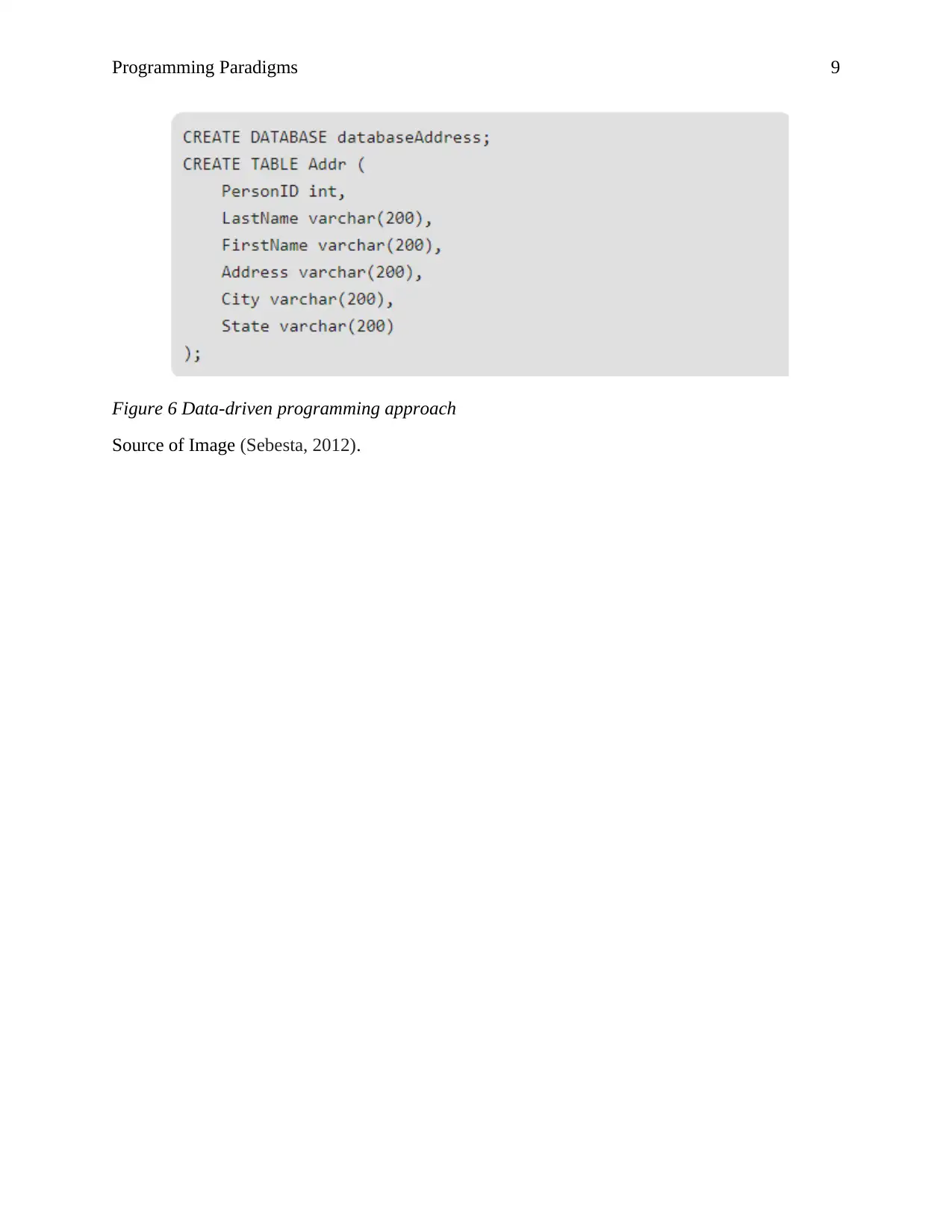
Programming Paradigms 9
Figure 6 Data-driven programming approach
Source of Image (Sebesta, 2012).
Figure 6 Data-driven programming approach
Source of Image (Sebesta, 2012).
⊘ This is a preview!⊘
Do you want full access?
Subscribe today to unlock all pages.

Trusted by 1+ million students worldwide
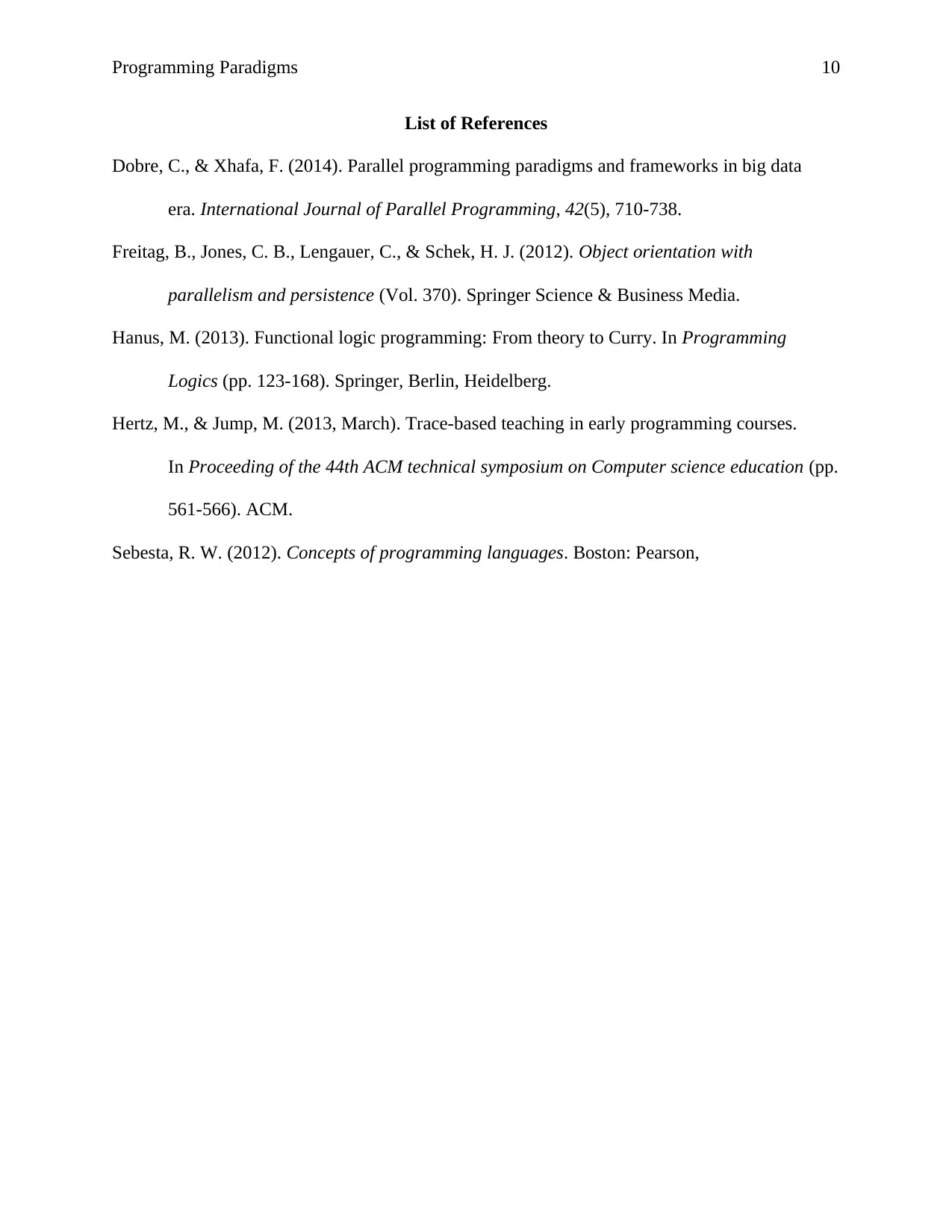
Programming Paradigms 10
List of References
Dobre, C., & Xhafa, F. (2014). Parallel programming paradigms and frameworks in big data
era. International Journal of Parallel Programming, 42(5), 710-738.
Freitag, B., Jones, C. B., Lengauer, C., & Schek, H. J. (2012). Object orientation with
parallelism and persistence (Vol. 370). Springer Science & Business Media.
Hanus, M. (2013). Functional logic programming: From theory to Curry. In Programming
Logics (pp. 123-168). Springer, Berlin, Heidelberg.
Hertz, M., & Jump, M. (2013, March). Trace-based teaching in early programming courses.
In Proceeding of the 44th ACM technical symposium on Computer science education (pp.
561-566). ACM.
Sebesta, R. W. (2012). Concepts of programming languages. Boston: Pearson,
List of References
Dobre, C., & Xhafa, F. (2014). Parallel programming paradigms and frameworks in big data
era. International Journal of Parallel Programming, 42(5), 710-738.
Freitag, B., Jones, C. B., Lengauer, C., & Schek, H. J. (2012). Object orientation with
parallelism and persistence (Vol. 370). Springer Science & Business Media.
Hanus, M. (2013). Functional logic programming: From theory to Curry. In Programming
Logics (pp. 123-168). Springer, Berlin, Heidelberg.
Hertz, M., & Jump, M. (2013, March). Trace-based teaching in early programming courses.
In Proceeding of the 44th ACM technical symposium on Computer science education (pp.
561-566). ACM.
Sebesta, R. W. (2012). Concepts of programming languages. Boston: Pearson,
1 out of 10
Related Documents
Your All-in-One AI-Powered Toolkit for Academic Success.
+13062052269
info@desklib.com
Available 24*7 on WhatsApp / Email
![[object Object]](/_next/static/media/star-bottom.7253800d.svg)
Unlock your academic potential
Copyright © 2020–2025 A2Z Services. All Rights Reserved. Developed and managed by ZUCOL.




